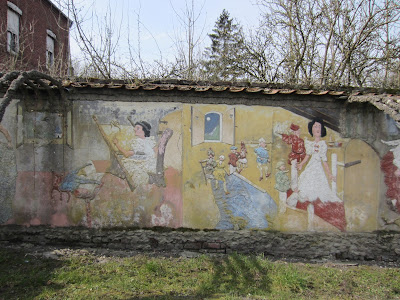 |
living room pictures by Pierre Schwartz courtesy of Hervé Perdriolle |
Only recently (autumn 2015) it has become known that in this street, right in the centre of Paris, an apartment was transformed into an art environment ¹.
Life and works
Jean-Daniel Allanche (1940-2015) was born in Tunisia and moved to France, where he did his studies. He got married in 1962, but the relationship ended in 1968.
Professor of physics at the Faculty of Sciences Paris 7, in 1975 he bought the apartment in the rue des Ciseaux.
From the late 1970s on, bit by bit, he has decorated the apartment, working over and over again to accomplish it, but although this activity must have played an important role in his life, he was not very talkative about it.
In the course of the years Allanche has actually painted all available surfaces of the apartment, not just the walls, but also the ceilings, the floors, cabinet doors and step treads. Moreover he also displayed the many African and Indian sculptures he had collected when he was teaching as a professor in Congo and Burkina Fasso (1989-1995).
The multicolored paintings have whimsical motives, sometimes formed by a large number of dots or small circles, combined with vaguely represented people and animals. In some places texts are arranged and on one of the doors his surname appears.
Such a view is supported by a remark in one of Allanche's notebooks, where he says that he has managed to show the intimate relationship between musical harmony and colors.
Je me dresse face à la mort
moi sujet singulier
SOUS TON REGARD
tout homme doit être vu
pour lui donner son âme vivante
(I stand up to death/me singular subject/in your view/every man must be seen/
to give him his living soul)
to give him his living soul)
 |
| kitchen |
Allanche's legacy also includes a number of gouaches and oil paintings in the same style as the wall paintings. They mainly date from the late 1970s and maybe were made as designs for (parts of) his wall paintings ².
And then he left a large number of notebooks. which include personal remarks and aphorisms, but also hundreds of pages with sequences of numbers, which has to do with a passion for gambling and his endeavor (he was a professor of physics) to model disorder.
 |
| bedroom |
Allanche died in hospital in August 2015 from an incurable disease.
It wasn't realistic to assume that Allanche's small and indoor situated apartment could be saved as kind of a museum for the general public, so it has kept it's function as a private apartment. Removable parts of this art environment have been stored. In the future they might become part of the collection of a French museum.
Documentation
* The physics of disorder. Brochure by Hervé Perdriolle, Paris (Galerie Hervé Perdriolle), 2015. ill.* Emptying the flat new material became available which late 2016 has been included in a new brochure L'Atelier moléculaire de Saint-Germain-des-Prés (The molecular studio of Saint Germain des Prés). Paris (Galerie Hervé Perdriolle), 2015, ill
*Article on ABCD website, especially about Allanche's notes about combinations of numbers
Notes
¹ To my knowledge the only available source about Allanche's art environment as such is the brochure by Hervé Perdriolle, so I like to acknowledge that the data in this post are derived from this brochure (interpretations are my responsibility)
² Galerie Hervé Perdriolle has presented a number of Allanche's loose-leaf works on the Outsider Art Fair in New York in January 2016. Website Artspace (January 22, 2016) wrote about Allanche in an article reviewing the art fair
first published December 2015, revised January 2016
Jean-Daniel Allanche
Apartement décoré
(formerly) Rue des Ciseaux
Ile de France, Paris VI, France
site doesn't exist anymore

































